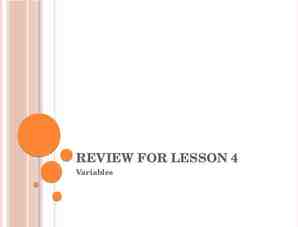The Money Market Gavin Cameron Tuesday 27 July 2004 Oxford
20 Slides145.50 KB
The Money Market Gavin Cameron Tuesday 27 July 2004 Oxford University Business Economics Programme
what is money? What is money? M0 money in circulation M1 M0 sight deposits M2 M1 unrestricted time deposits at banks M3 M2 fixed-term time deposits non-bank deposits Inside (fiat) money, outside money. Money in December 2000 UK bn % GDP Euroland bn % GDP USA bn % GDP Currency 27.1 3.0 347.5 1.2 530.5 2.9 M1 459.8 47.9 2074.3 15.8 1091.3 11.0 M2 804.5 85.0 4287.2 25.5 4945.7 5.0 M3 926.1 96.7 5080.0 35.3 7098.8 71.7
the money multiplier When someone deposits 100 in cash in a bank, the Federal Reserve requires the bank to set aside some portion as a reserve. The money multiplier depends upon three factors: the reserve requirements imposed by the Federal Reserve (rr); the proportion of excess reserves to deposits that banks maintain (ee); the ratio of currency to deposits that households and businesses prefer (cc). When currency is C, bank deposits are D, and reserves are R: M0 C R ccM1 rrD M1 C D ccM1 D Since D (1-cc)M1 M0 (cc rr(1-cc))M1 The money multiplier is therefore m 1/(cc rr(1-cc))
money demand Functions of Money: Medium of exchange Unit of account Store of value Standard of deferred payment The return on assets: rate of interest liquidity premium-depreciation-carrying-cost Transactions (Inventory), Precautionary, and Portfolio (Speculative) Portfolio Demand. Real income elasticity of money demand in the USA is 0.06 in the first quarter, 1.18 in the long-run. A one percentage point rise in the real interest rate reduces money demand by 0.12% in the first quarter, and 2.40% in the long-run.
bond prices and the interest rate Because the interest rate affects how much people discount the future, the price of a bond depends upon the interest rate. Consider a simple bond that pays 100 Euros in a years time. How much is this worth today? PDV 100/(1 r) if the interest rate is 5%, the bond is worth 100/1.05 95.2 if the interest rate is 10%, the bond is worth 100/1.1 90.9 Consider a bond that pays a fixed coupon, a, forever: The price of that bond will be a/r. A similar argument can be made for the value of any asset that pays some return over some period of time, although the calculation becomes more difficult when the return is uncertain, as in equities.
the demand for real money interest rate A fall in the interest rate increases money demand, down the real money demand schedule. L(r,Y2) L(r,Y1) M/P A rise in income increases money demand, shifting the real money demand schedule outwards.
the money market interest rate MS L(r,Y2) L(r,Y1) M/P If the public wants to hold more money at present, they will sell bonds and other securities in order to try to acquire more cash. This bids down the price of securities, and hence raises their interest rate. The rise in the interest rate reduces demand for money just sufficiently that the entire money stock is willingly held. A rise in money demand, holding the money supply constant, raises the interest rate.
interest rates and monetary targets interest rate MS1 MS2 B A L(r,Y2) C L(r,Y1) M/P If the public wants to hold more money, the central bank can decide not to respond, in which case interest rates rise (B), or to keep the interest rate unchanged (C).
open market operations On any normal business day, some commercial banks hold reserves in excess of those required, and some fall short. The money market allows banks to trade excess reserves, borrowing and lending at very short maturities (the US federal funds rate, the EONIA in Euroland). The central bank is the ultimate supplier of bank reserves (the commodity traded in the money market) and can therefore use open-market operations (short-term loans) to increase or decrease liquidity in the market.
money growth is volatile
why is money growth volatile? Month-to-month monetary base growth rates are very, very noisy. Banks' demands for reserves and public demand for currency fluctuates a lot on a month-to-month basis, especially when expressed as an annual growth rate. For example, take a look at the month-to-month changes in the monetary base since the start of 2000 on previous slide. But does this bounciness mean that monetary policy is extraordinarily restrictive one month and extraordinary expansionary another? No. It just means that the demand for high-powered money is noisy, and thus that a central bank that wants to stabilize short-term interest rates (or any of the broader measures of the money stock) will find that it has to make the monetary base bounce around considerably from month to month.
the LM curve interest rate interest rate MS LM curve L(r,Y2) L(r,Y1) M/P Y1 Y2 As national income rises, more real money balances are demanded. For a given money supply, this leads to a rise in the interest rate. Y
the ISLM diagram interest rate LM IS Y Combining the IS curve with the LM curve gives the famous ISLM diagram introduced by John Hicks in 1937. At the intersection of the two curves, both the goods and money markets are in equilibrium. One problem with this framework is that it assumes fixed prices.
money market and rising prices What is the effect of higher prices on the money market? Higher prices mean that consumers need more money for transactions. The only way they can hold more money for transactions is by holding less for speculative purposes. Speculative demand falls when interest rates rise, therefore interest rates must rise. Another way to think of this is that the public try to sell bonds in order to raise their cash balances. Bond prices fall and therefore interest rates rise. Of course, in equilibrium, all bonds and money must be held by someone, so it is the rise in the interest rate that enables the money market to reconcile the rise in money demand with the fixed money stock.
ISLM and rising prices interest rate LM(P2) LM(P1) IS Y A rise (fall) in the price level shifts the LM curve inwards (outwards). This is sometimes called the Keynes effect. The effect is to raise the interest rate, which reduces the level of interestsensitive spending (e.g. investment) in the economy, and hence reduces output (the move up the IS curve).
AD curve Why does the AD curve slope downwards? Real Balance Effect; Real Exchange Rate; Keynes Effect. price level AD Y
ASAD price level LAS SAS AD Y The economy is in equilibrium when aggregate supply equals aggregate demand – there is no tendency for inflation to rise or fall. In the long-run, aggregate supply is determined by the capacity of the economy. In the short, resources may be under or over-utilised.
summary The public holds money because of its use for transactions, precautions, and speculation. The narrow money supply depends directly upon note issuance by the central bank. The central bank can also influence the amount of broad money in circulation through open market operations. In practice it is usually easier for the central bank to affect the interest rate. The relationship between the interest rate and output in the money market is called the LM curve. As prices fall (rise), the LM curve shifts outwards (inwards) – the Keynes effect. This gives us the AD curve, which we can combine with an AS curve.
the theory of short-run fluctuations Keynesian Cross IS Curve IS-LM model Money Market AD curve AS-AD model LM Curve AS curve
syndicate topics What is the effect on the velocity of money of an unexpected increase in the rate of inflation that is: (a) temporary? (b) permanent? How is the demand for money affected by (a) the introduction of cash machines, and (b) a rise in interest rates? The central bank can control the monetary base, but not its breakdown between currency and bank’s reserves. Why not? Who does decide? Why is there a link between the government deficit and the money supply? If inflation is positive, simply maintaining the nominal money supply at some constant level amounts to a contractionary monetary policy. True or false?

























